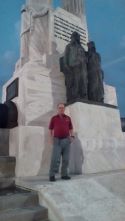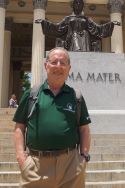May 22, 2017
Welcome to Havana
I’m going to start with two numbers, and use them to talk about some of the things in Havana that we’ve learned in the last day or so. The first is $750, and the second is 11 million.
 The first number refers to the published rate for the hotel where I’m staying (although the Nacional’s $750 is for the high season, and the low season—now–is “only” $250). It’s a historic hotel in the Vedado district, facing the Caribbean. With a Moorish lobby, it was built in 1930, and became a fixture in the ancien regime. The museum has pictures of famous celebrities, such as Ava Gardner and Frank Sinatra, who once graced its gambling casinos. The Mafia had an international convention here when Havana hosted hoods. Today, it’s full of tourists who have discovered Havana as a destination. That includes North Americans, although our visits are regulated under Treasury Department restrictions. There are 13 categories permitted, including our Certificate granting educational visits, which is why we’re having 8 hours or so of class every day; and Americans can’t come to Cuba to enjoy the beaches.
The first number refers to the published rate for the hotel where I’m staying (although the Nacional’s $750 is for the high season, and the low season—now–is “only” $250). It’s a historic hotel in the Vedado district, facing the Caribbean. With a Moorish lobby, it was built in 1930, and became a fixture in the ancien regime. The museum has pictures of famous celebrities, such as Ava Gardner and Frank Sinatra, who once graced its gambling casinos. The Mafia had an international convention here when Havana hosted hoods. Today, it’s full of tourists who have discovered Havana as a destination. That includes North Americans, although our visits are regulated under Treasury Department restrictions. There are 13 categories permitted, including our Certificate granting educational visits, which is why we’re having 8 hours or so of class every day; and Americans can’t come to Cuba to enjoy the beaches.
The old city is about a mile away, and I can see the harbor where in February 1898, the battleship Maine, sent to protect American interests during Cuban’s (second?) war for independence, blew up, bringing an end to Cuba’s almost 400 years of  Spanish rule. That instituted nearly 60 years of US “protection”, which included support f
Spanish rule. That instituted nearly 60 years of US “protection”, which included support f or the anti-Communist dictator Sgt. Batista, dethroned in 1959 by Fidel Castro (beginning a verbal, political, and economic contest only partially abated when President Obama re established diplomatic relations in 2014).
or the anti-Communist dictator Sgt. Batista, dethroned in 1959 by Fidel Castro (beginning a verbal, political, and economic contest only partially abated when President Obama re established diplomatic relations in 2014).
The past is still alive in the many buildings from the colonial and republican period, many of them refurbished and restored. While property values have increased in the last few years, you can buy one of them for under $300,000—far less than anything comparable in Chicago—but this is a strictly cash economy, based on socialist characteristics, with about 75% of the economy under state control, and an average income of under $400 a month. Many services are free, though, including health care and education.
 The past is alive, too, in the old cars. I would have loved to have been able to buy a 50s Ford Fairlane, or a Chevy Belaire or Impala; alas, I couldn’t afford them then, and I was told the cost would be $50,000 now. It is not an old car; it’s a collector’s item.
The past is alive, too, in the old cars. I would have loved to have been able to buy a 50s Ford Fairlane, or a Chevy Belaire or Impala; alas, I couldn’t afford them then, and I was told the cost would be $50,000 now. It is not an old car; it’s a collector’s item.
The Castro dynasty is still in power, with Raul as Castro II, president of the Council of State, but Fidel’s works and the results of the revolution are still present. For example, I got off the plane and drove past Lenin Park in a Skoda (Czech) taxicab. Cubans of a certain age (pre collapse of the Soviet Union), reminisce about the good old days, when the economy flourished with Soviet support. In response to the US embargo in the early 1960s, Cuba sold its sugar crop to Russia, and acquired Russian advisors and military assistants who almost ignited the cold war to full flame in 1962. I remember that well, and got a look at the bunkers here on the hotel grounds, where Castro set up his command post. Fortunately, Khrushchev pulled his missiles back, but that hardened US political and economic policies toward Cuba; the embargo is still in effect, and American subsidiaries are not allowed to trade with Cuba. In addition, ships that call at Cuban ports are barred from landing in the US for six months. The result since the collapse of Russia has been economic hard times that persist in shortages. Here at the hotel, for example, they had no pineapple juice for the pina coladas the hotel is famous for, and ran out of ice cream. As one of our speakers noted, even if you have money and influence, if it’s not available, it’s not available.

 There are other Fidel and Soviet period effects. Billboards with sayings of Fidel dot the roadsides, in the same way that Chairman Mao sayings are on the walls of the Forbidden City. One of the mementos I had to take a picture with was at the University of Havana. Started in 1728, the prestigious university has a main plaza with five “faculty” buildings surrounding it. One is the law school, where Castro studied in the 1950s. In front of the law school, there’s a tank, donated in memory of the students who fought to overthrow Batista at the battle of Santa Clara. Not many campuses would have a similar display.
There are other Fidel and Soviet period effects. Billboards with sayings of Fidel dot the roadsides, in the same way that Chairman Mao sayings are on the walls of the Forbidden City. One of the mementos I had to take a picture with was at the University of Havana. Started in 1728, the prestigious university has a main plaza with five “faculty” buildings surrounding it. One is the law school, where Castro studied in the 1950s. In front of the law school, there’s a tank, donated in memory of the students who fought to overthrow Batista at the battle of Santa Clara. Not many campuses would have a similar display.
The second number of 11 million is the population of Cuba, and the effect of that number will have to await a chance tomorrow to tell you more of what I’m learning here in Cuba, 23 degrees north of the equator (but I couldn’t bring my GPS).